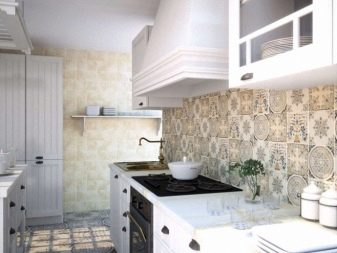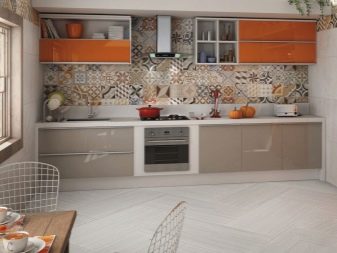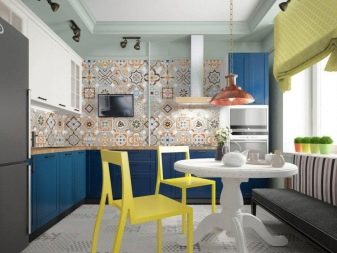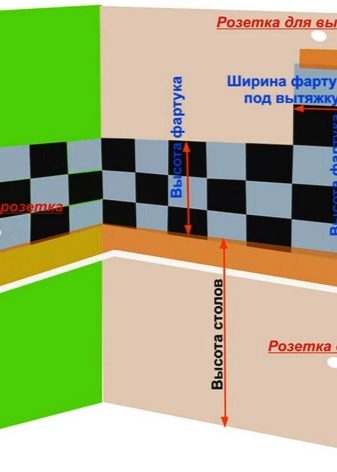Patchwork tiles for an apron for the kitchen: varieties and tips for choosing

An interesting solution in the design of the kitchen interior can be the design of the apron in the kitchen with patchwork tiles. There are a lot of variations of such an apron - these are contrasts not only in black and white, but also in other colors or a calm combination of patchwork tiles of the same tone, the size of the tile can be tiny or, conversely, large. Let's talk about the rules for creating and the features of a patchwork kitchen apron.


Style
Patchwork comes from English patchwork. Translated, this word means "from scraps." Patchwork is a style that has come down to us from ethnic depths, when every piece of fabric was appreciated and used. Although the British are considered the ancestors of the patchwork style, the motives of this technique can be seen in traditional textiles of many peoples of the world. The patchwork trend is relevant to this day, the patchwork style is used not only in things and clothes, but also in interior design.


For a kitchen apron, this style turned out to be very appropriate: the combination of various colors and patterns will delight the eye, make the interior of the kitchen boring and can become the main highlight of the kitchen. At the same time, the general style of the kitchen room can be both traditional, classic, and modern, with the latest kitchen appliances. But not in any interior, a patchwork kitchen apron will add coziness, originality and warmth.
You should not use it in an environment in which chaos reigns, there is no order, because with its variegation, patchwork in the kitchen will bring even greater disharmony.


Views
The modern repair and construction industry offers the widest selection of patchwork tiles for every taste.Such a tile can be of an average size of 10x10 cm, very small, mosaic or large, with an imitation of several tiles on one large one.
The texture can also be different - rough or smooth, glossy or matte. The tile material can be either traditional (ceramics) or non-standard (glass or metal). The budget option is plastic tiles. In the latter case, it is better to choose large-size refractory high-quality plastic that does not bend under finger pressure.


But the main criterion for choosing a patchwork tile is the colors and patterns on it. The color of the tiles can be monochromatic, the so-called monochrome, be without a pattern, or combine a different repeating pattern.
Among the patterns, abstraction from geometric shapes, ethnic motifs, floral elements, stripes, checks or polka dots are popular. And also interesting and eye-catching patchwork tile is contrasting in color - black and white, white and blue, red and black, laid out in a checkerboard pattern or in another order. The combination of tiles of two or more matching colors in the kitchen apron looks original, having an overlap with the general interior of the kitchen.



How to choose?
Before decorating an apron in a patchwork kitchen, you should consider a few of the nuances of such a tile.
- Since the patchwork pattern is a self-sufficient and vibrant style that does not require additions, use it sparingly, otherwise you can ruin the interior by overloading the area that the patchwork decorates. That is, it is better to choose a laconic place for an apron in the kitchen using the patchwork technique. It is not customary to simultaneously decorate the floor, walls and curtains in a patchwork style.


- Patchwork details look more advantageous against a plain background. This means that the kitchen set should not be flashy against the background of patchwork tiles and have abundant fittings. Even kitchen utensils and kitchen utensils in the kitchen and furniture, where there are patchwork elements, should be in calm, neutral colors. So, the noble gray metallic color of kitchen furniture and appliances is ideal for the classic black and white patchwork with fancy geometry.


- Small to medium sized tiles can be laid out in any order. Here you can show a creative flight. Large tiles, imitating several tiles, dictate the layout only in a certain order.


- The size of the tiles should be chosen based on the size of the kitchen. The larger the kitchen area, the larger the tile will fit. In small rooms, medium (10x10 cm) and small sizes (mosaic, smalt) are appropriate.


- The surface of the tiles does not really matter, but the same pattern on a rough and smooth surface will look different. It should also be taken into account that a smooth surface is better washed off.



- The picture on the tiles looks the most harmonious, in which it can be traced clear diagonal in different patterns and in matching shades.


- It is better to purchase tiles from one manufacturer.trying to buy the required number of items from one collection.
Items with the same pattern, but from different collections, may differ in color.


Installation recommendations
There are a few styling tips from the experts to take into account.
- When laying patchwork tiles on your own, you should first place it on the floor (especially if tiles from different styles are used) in order to see and appreciate the full picture of the future kitchen apron. Designers recommend taking a photo of the tiles laid out on the floor and thinking about this option for several days. If the result does not disappoint during this time, you can safely get down to work. If necessary, you can take a photo of several variations of the layouts and discuss them with your household.


- Many leading manufacturers offer ready-made patchwork tile sets.In order not to think carefully about laying out a patchwork pattern, the optimal solution would be to choose a ready-made set of matching tiles 10x10 cm.


- On the wall, you should mark with a pencil or chalk the places of the kitchen kit, stove, refrigerator, wall cabinets - those interior items that will border on the kitchen apron. If it is not possible to measure the kitchen set, you should use the standard dimensions: height from the floor - 85 cm, height from the countertop to wall cabinets - 70 cm.


- After that, it is necessary to outline the edges of the cladding and fix a metal profile or a block of wood at the lower border. The upper and lower parts of the apron should go under the kitchen furniture by 0.2–0.5 cm. Next, start laying the tiles using a generous layer of glue.


- It is not unimportant to measure the level of symmetry of the lines after laying out each row of tiles. Large glossy tiles will create the optical effect of a single canvas, without seams, if you use a thin grout layer. The joints should be treated with a water-repellent antifungal solution.


- The patchwork should not break off abruptly. Border the edges of the apron made of patchwork tiles with wallpaper or elements of the same shades as the tile.


For information on how you can lay out an apron in the kitchen with patchwork tiles, see the next video.








